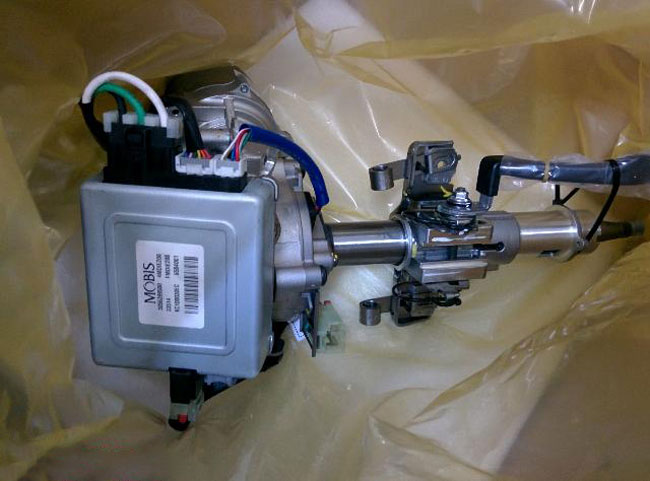Ever had your car’s Electronic Power Steering (EPS) system suddenly stop working? It’s not just frustrating—it can be downright dangerous. Understanding the possible causes of an EPS malfunction can help you stay ahead of potential issues and keep your vehicle running smoothly.
In this text, I’ll jump into the common reasons behind EPS failures, from electrical faults to software glitches. Whether you’re a seasoned driver or a car enthusiast, knowing these causes can save you time, money, and a lot of headaches. Let’s get into the nitty-gritty of what might be going wrong under your hood.
Main Types of EPS Malfunction
Electronic Power Steering (EPS) malfunctions can occur due to several reasons. Understanding these issues helps maintain optimal vehicle performance. Here are the main types of EPS malfunctions.
Motor Issues
EPS systems rely on an electric motor to provide steering assistance. Problems with this motor can lead to a malfunction. Factors include:
- Overheating: Excessive use in high temperatures can cause the motor to overheat and fail.
- Wear and Tear: Continuous usage can wear out the motor components, leading to a reduction in its efficiency.
- Electrical Problems: Faulty wiring or electrical connections can impede the motor’s function.
Electronic Board and Circuitry Problems
The electronic control unit (ECU) and circuits manage the EPS system. Issues here can disrupt steering functionality.
- Corrosion: Moisture or contaminants can cause corrosion on electronic components, leading to failures.
- Software Glitches: Erroneous software updates or bugs can negatively impact the EPS control functions.
- Component Failure: Critical elements like resistors or capacitors may fail, disrupting the EPS system.
Torque Sensor Failures
The torque sensor measures the driver’s steering effort and adjusts the motor assistance. Failure in this sensor affects steering accuracy.
- Sensor Drift: Over time, the sensor’s accuracy can drift, leading to incorrect readings.
- Electrical Interference: Other electrical systems in the vehicle can interfere with the sensor’s function.
- Mechanical Damage: Physical damage to the sensor can impair its operation, affecting the EPS performance.
Understanding these common causes helps identify and address EPS malfunctions more efficiently. Regular maintenance and timely checks can preempt these issues, ensuring safer and smoother driving experiences.
Identifying Symptoms of EPS Issues
Recognizing symptoms of Electronic Power Steering (EPS) issues helps prevent serious malfunctions. Awareness and early detection ensure safer driving conditions.

Steering Wheel Difficult to Turn
Difficulty in turning the steering wheel indicates possible EPS issues.
- Stiffness: When the steering wheel feels stiff and unresponsive.
- Resistance: Notable resistance while making turns at low speeds, which shouldn’t occur.
- Gradual Onset: This stiffness often appears gradually, so it’s crucial to monitor any changes over time.
Uneven Left-Right Power Steering Assist
Inconsistent assistance when steering left vs. right points to EPS malfunctions.
- Imbalance: One side may feel lighter or heavier than the other.
- Steering Lag: Delay or lag when turning in one direction.
- Correction Efforts: Constant need to make corrections to keep the vehicle straight.
Unusual Sounds in the Steering Wheel
Odd noises emanating from the steering wheel often signal EPS problems.
- Clicking: Repeated clicking sounds during turns or maneuvers.
- Whining: High-pitched whining noise while steering, that varies with speed.
- Grinding: Grinding or creaking noises, indicating potential mechanical faults.
Assistive Torque Irregularities While Driving
Erratic assistive torque while driving may result from EPS issues.
- Switching: Sudden switching of torque assistance, creating instability.
- Obstructed Drives: Changes in torque assistance during normal driving, causing discomfort and difficulty.
- Erratic Movement: Unpredictable adjustments applying uneven torque.
Recognizing these symptoms can lead to timely EPS system inspections and repairs, minimizing potential hazards and ensuring a smoother driving experience.
Diagnosing EPS Malfunction
Identifying the root cause of an Electronic Power Steering (EPS) malfunction is critical for maintaining vehicle safety and performance. I’ll outline several diagnostic steps to effectively troubleshoot EPS issues.
Key Diagnostic Tools:
- OBD-II Scanner: A device that reads error codes from the vehicle’s onboard diagnostics system.
- Multimeter: An instrument used to measure electrical voltage, current, and resistance.
- Service Manual: The official repair guide that provides wiring diagrams and troubleshooting procedures.
Diagnostic Steps:
- Check Error Codes: Connect the OBD-II scanner to the vehicle’s diagnostic port to retrieve error codes. Common codes include C0545 (steering torque sensor malfunction) and P0606 (control module fault). Refer to the service manual for code interpretation.
- Inspect Electrical Connections: Ensure all wiring harnesses and connectors related to the EPS system are secure and free from corrosion. Loose or corroded connections can cause intermittent faults.
- Test Battery Voltage: Use a multimeter to verify the battery’s voltage. A failing battery or poor charge can lead to EPS malfunctions. Battery voltage should be within the range of 12.4 to 12.7 volts when the engine is off.
- Examine EPS Fuses and Relays: Locate the EPS-related fuses and relays in the vehicle’s fuse box. Check for blown fuses and test relays for proper operation with a multimeter.
- Assess Steering Motor: The EPS motor, responsible for providing the steering assist, can fail due to wear and tear. Listen for unusual noises from the steering motor during operation and test for correct motor resistance.
- Evaluate Torque Sensor: The torque sensor measures the amount of force applied to the steering wheel. A failed sensor can result in erratic steering assistance. Cross-check sensor readings with the specifications provided in the service manual.
- Software Updates: Ensure the EPS control module has the latest software updates as manufacturers often release patches to fix known bugs and improve functionality.
Commonly Used Terms:
- OBD-II: On-Board Diagnostics system used to monitor and report on various vehicle subsystems.
- Multimeter: A tool for measuring electrical properties such as voltage, current, and resistance.
- Torque Sensor: A device that senses the rotational force applied to the steering wheel.
- EPS Motor: An electric motor that provides the necessary assistance for steering.
Effective diagnosis not only identifies EPS issues but also aids in preventing similar malfunctions in the future. Ensure comprehensive checks, from error codes to physical inspections, for reliable vehicle operation.
Preventative Measures and Maintenance
Maintaining the Electronic Power Steering (EPS) system with regular upkeep ensures optimal performance and prevents malfunctions. I’ll outline key preventative measures and essential maintenance tasks for the EPS system.
Regular Inspections
Consistent check-ups identify potential issues before they escalate.
- Visual Checks: Inspect the EPS motor, wiring, and connectors for wear or damage.
- Fluid Levels: Ensure steering fluid levels are adequate if your system uses hydraulic assistance.
- Error Codes: Use an OBD-II scanner to check for stored or pending fault codes.
Electrical System Maintenance
The electrical components of the EPS system are crucial to its operation.
- Battery Health: Test the battery regularly to confirm it meets voltage requirements.
- Clean Connections: Keep electrical connections clean and corrosion-free.
- Fuse and Relay Inspection: Check EPS fuses and relays periodically for signs of wear or damage.
Software Updates
Software is integral in modern EPS systems.
- Firmware Updates: Keep the EPS software updated to the latest version. Manufacturers often release updates addressing known issues.
- Calibration: Recalibrate the EPS system after any service or software update to ensure accuracy.
Steering Component Maintenance
Ensuring all steering components work correctly is vital.
- Torque Sensor: Test the torque sensor regularly for accurate readings.
- Steering Motor: Listen for unusual noises from the steering motor, indicating potential issues.
- Alignment: Regular wheel alignment checks prevent undue stress on the EPS system.
Driving Habits
Good driving habits contribute to the longevity of the EPS system.
- Avoid Excessive Force: Don’t force the steering wheel to its limit stops.
- Smooth Turns: Make smooth and controlled turns to reduce strain.
Action Points
Adopting these preventative measures ensures the EPS system remains in peak condition, extending its lifespan and maintaining vehicle safety. Regular maintenance, timely inspections, and adopting good driving habits contribute to the seamless operation of the EPS system.
Conclusion
Understanding the potential causes of EPS malfunctions can significantly enhance your vehicle’s safety and reliability. By staying vigilant about early detection and adhering to regular maintenance routines, you can prevent many common issues. Prioritizing regular inspections, updating software, and maintaining the electrical system will help extend the lifespan of your EPS. Remember, good driving habits also play a crucial role in keeping your EPS in top condition. Taking these proactive steps ensures you’re not only preserving your vehicle’s performance but also safeguarding your driving experience.
Frequently Asked Questions
Where is the EPS sensor located?
The steering torque or force sensor is typically mounted on or inside the steering rack and connected to the pinion gear. This location allows the control unit to confirm the data in real time.
Is it safe to drive with the EPS light on?
Driving with the EPS light on can be challenging as the steering will be heavier and turning more difficult. It becomes almost impossible to react quickly at higher speeds, making accidents far more likely.
What would cause my EPS light to come on?
A bright EPS light might indicate an electrical fault in the electronic power steering system. Unlike hydraulic systems, EPS has no fluid, so the issue is usually an electrical malfunction.
What is the EPS engine warning?
The EPS or EPAS warning light indicates a problem with the power steering. For electric systems, this might be as simple to fix as rebooting a computer. Find a safe place to stop, turn off the car, and restart it after 30 seconds.
What happens if EPS fails?
If the electric power steering fails, you can still steer normally, but the steering will feel heavier, especially at slow speeds or during sharp turns. You might also see a warning light on the dashboard.

